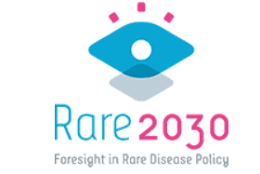The Health Strategist
institute for continuous health transformation
and digital health
Joaquim Cardoso MSc
Chief Research and Strategy Officer (CRSO)
May 10, 2023
KEY MESSAGES:
- the field of rare disease research necessitates tailored approaches to predict safety, personalize clinical trials, and address issues of access and equity.
- Collaboration, data sharing, adaptive trial designs, wearable technology, and a focus on inclusivity are all critical components of advancing research and improving outcomes for individuals affected by rare diseases.
ONE PAGE SUMMARY
This executive summary highlights the innovative approaches being pioneered by rare-disease researchers in the field of clinical trials.
- Traditional methods such as randomization and placebo groups are being replaced with alternative strategies that leverage biomarkers, real-world data from wearables, and multi-center and adaptive trials.
Rare diseases pose a significant challenge due to their low prevalence, with over 7,000 diseases affecting fewer than 200,000 Americans, as reported by the US Food and Drug Administration (FDA).
- Developing safe and effective treatments for these diseases is a complex task.
- However, modified clinical trials and the utilization of real-world data show promise in addressing this challenge.
The European Medicines Agency (EMA) defines a disease as rare if it affects fewer than 5 individuals in 10,000.
- This broad classification encompasses well-known diseases like sickle-cell disease, as well as more obscure conditions such as aceruloplasminemia, Schnitzler syndrome, and Waldenström macroglobulinemia.
Furthermore, even within a single rare disease, there can be multiple subtypes that necessitate personalized treatment approaches.
- For instance, cystic fibrosis affects approximately 1 in 2,500 newborns.
- Over the years, advancements in genetic research have revealed that different mutations in the genome can cause this disease, further complicating patient identification and eligibility screening for clinical trials.
The paper emphasizes the need for innovative and adaptive approaches to clinical trials in the realm of rare diseases.
- By leveraging biomarkers, real-world data, and multi-center collaborations, researchers are making strides in the development of safe and effective treatments for these conditions.
- These advancements have the potential to improve the lives of individuals affected by rare diseases and address the significant unmet medical needs within this field.
The summary focuses on the unique challenges and innovative strategies in predicting safety, personalizing clinical trials, and ensuring equitable access in the context of rare diseases.
- With the emergence of novel treatments like gene editing, traditional approaches to demonstrating safety and efficacy need to be reevaluated.
- Pre-clinical testing using animal models may not sufficiently predict outcomes in humans, as observed in cases like myotubular myopathy where patients experienced unexpected adverse effects due to pre-existing conditions.
To address the complexity of rare diseases and their personalized treatment requirements, researchers are exploring individualized approaches such as n-of-1 trials and academic-industry collaborations.
- Sharing data, especially concerning safety and unsuccessful outcomes, is crucial in rare disease research.
- Adaptive trials, which allow for adjustments in real-time based on trial progress, and decentralized trials, leveraging virtual consultations and wearable technology, are being employed to enhance enrollment and data collection.
Biomarkers play a vital role in personalized clinical trials, particularly in diseases with different rates of progression.
- Surrogate biomarkers, such as protein levels, are used to predict clinical benefits in diseases that progress at intermediate rates.
- Furthermore, the use of wearables and real-world data collection holds great potential in transforming clinical research design and outcomes. However, standardization and collaboration are necessary to maximize the value and reliability of wearable technology data.
The paradigm of placebo-controlled trials is being challenged in rare diseases due to ethical concerns and patient preferences.
- Single-arm trials and synthetic control arms are being considered alternatives to traditional placebo arms.
- The design and implementation of adaptive trials require increased statistical analysis, but they are necessary for establishing efficacy and safety in rare diseases.
Moreover, ensuring equitable access to clinical trials and treatments is a crucial consideration, particularly for diseases prevalent in low- and middle-income countries.
- Inclusion of populations most affected by the disease being studied, such as conducting clinical trials in the countries with a high burden of disease, is essential.
- Overcoming infrastructure limitations and fostering research capacity in these regions is a key focus.
- Additionally, efforts should be made to ensure that the benefits of research and treatments reach all populations, irrespective of their income levels.
DEEP DIVE

Rare-disease researchers pioneer a unique approach to clinical trials
Nature
Mike May
Randomization and placebo groups are giving way to biomarkers, real-world data from wearables, and multi-center and adaptive trials.
In the development of new treatments for rare diseases, a crucial challenge lies in the name: rare.
Despite their being rare, there are many of these diseases, with more than 7,000 diseases that each affect fewer than 200,000 Americans, according to the US Food and Drug Administration (FDA). Researchers are continually trying to develop safe and effective new treatments for thousands of rare diseases, but it is difficult.
Some of the most promising approaches lie in modified clinical trials and making use of real-world data.
The European Medicines Agency (EMA) defines a disease as rare if it afflicts fewer than 5 people in 10,000.
The list includes well-known diseases, such as sickle-cell disease, and more-obscure diseases, such as the neurodegenerative disease aceruloplasminemia, the autoimmune disorder Schnitzler syndrome, and Waldenström macroglobulinemia, a type of lymphoma.

Even within one rare disease, many subtypes can exist that require personalized approaches to therapy.
As one example, EMA’s chief medical officer Steffen Thirstrup mentions cystic fibrosis, which affects around 1 in 2,500 babies born.
“When I left medical school 30 years ago, we knew that cystic fibrosis was caused by a genetic defect, but now we know that different mutations in the genome can cause this disease,” he explains.
“So now, you actually start to subsegment this rare disease, which adds additional complexity to finding patients and screening them to find out whether they’re eligible for a trial.”

Predicting safety
Some of the treatments for rare diseases, such as gene editing, are relatively new and therefore require different approaches to demonstrating safety and efficacy. As Peter Marks, director of the FDA’s Center for Biologics Evaluation and Research, explains, difficulties with testing treatments for rare diseases start at the pre-clinical stage. “As we move into the era of genome editing, some of our paradigms, such as using animal models to do toxicology testing and pre-clinical testing, only take us so far,” he says. For example, a drug might work as desired in an animal model but create undesirable effects in humans.
As one such example, Annemieke Aartsma-Rus, professor of translational genetics at the Leiden University Medical Center in the Netherlands, mentions the muscle disease myotubular myopathy, which affects 1 in 50,000 male newborns worldwide. There is “a dog model where gene therapy worked really well, preventing muscle pathology, but some patients experienced severe liver problems,” when the drug was tested in humans, she says. As it turned out, those patients already had liver complications, which the treatment exacerbated. As Aartsma-Rus notes, “A treatment can have different effects in a pathological tissue than in a healthy tissue,” and that might not be identified in animal models.
Aartsma-Rus develops treatments based on antisense oligonucleotides for patients with very rare mutations or even individual cases, so-called n-of-1 trials. Side effects of personalized therapies will be seen only after they are tested in humans, she says: “So far, there’s not really a solution for predicting this, and the only real proof is your actual patient.”
Academic-industry collaborations might enhance pre-clinical safety studies. “Pharmaceutical companies probably have a lot of data on what is safe and what is not, but [academics] don’t have access to that,” Aartsma-Rus says. She works on Duchenne muscular dystrophy, which affects 1 in 3,500 male neonates. For this disease, “companies are sharing the outcome measures of placebo groups, but not the treatment groups,” she says. Aartsma-Rus believes that sharing data on rare diseases should be mandatory, “especially for things that don’t work and in regard to safety — things that are toxic,” she says.

Benefits of biomarkers
On the clinical side, trials need to get more personalized. “Assuming that we’re talking about applications where handfuls of individuals — maybe 20, 30, 40 people — are available for a clinical trial, one has to start to really look on a very individualized basis,” Marks says. In a rapidly progressing rare disease, a trial can show a new treatment’s efficacy fairly quickly. “With a gene therapy for spinal muscular atrophy type 1, for example, you know within a year’s time if an intervention made a big difference,” he says.
If a rare disease progresses slowly, a clinical trial becomes more complex. “There, you need to understand some baseline of how somebody has been functioning to detect a treatment-based improvement over time,” Marks explains. “And you have to have enough patients treated that you can convince yourself that you have stopped some decline.”
For rare diseases that progress at an intermediate rate, clinical trials might rely more on surrogate biomarkers, such as the level of a pathogenic protein. “In such diseases, we’re hoping to use an enzyme level or protein-expression level to predict clinical benefit,” Marks says. “You might come in with a genome editor, restore a functional protein’s level, and then correlate that, either in animal models or in humans, with an improvement in the clinical outcome.”
Given this spectrum, rare diseases demand a unique approach to clinical trials. “We all have to essentially individualize development and how we look at safety and efficacy in these small populations, depending on the given indication, its severity, and how it progresses,” Marks notes.

Ditching the placebo
Given the small number of patients with a rare disease in any clinical trial, some experts advocate reducing the number of people who receive non-therapeutic doses. “Even in phase 1 studies, you want to make sure that the doses of any therapy are optimized as quickly as possible,” Marks explains. Skipping the very low doses could add a bit more risk to a clinical trial, says Marks, but such risk can be mitigated by detailed pre-clinical data from cell-based studies or animal models.
Trials for rare-disease treatments might even forego a placebo arm, instead using a single-arm trial. “If a new therapy is very promising, it might be unethical to have patients get a placebo or you may be in a situation [in which] patients do not want to enroll into the trial, because they fear ending up in the placebo arm,” Thirstrup says. Consequently, some trials put all of the patients on the treatment. Although this prevents comparisons with patients who do not get the treatment, efficacy could be determined in other ways, such as comparing a patient’s status during and after the trial to a baseline determined at the start of the trial, or using a synthetic control arm, wherein a placebo group is modeled on the basis of previously collected real-world data.
The traditional clinical trial with fixed treatment groups can be ill suited to rare diseases, with some researchers opting for adaptive trials. In an adaptive trial, “you look at the progression of the trial, and then you adjust — randomize in a different way, add patients, change the dose,” Thirstrup explains. “So, you gradually adapt your trial to find out where you get the best efficacy and in what population.” Although adaptive trials demand more statistical analysis, “it’s a simple fact that the sponsors need to do these types of trials to establish efficacy and safety, especially for rare diseases,” Thirstrup notes.
If researchers can enroll more patients with a rare disease in a trial, they can mitigate some of these challenges. An increasingly popular approach to that is through decentralized trials, in which patients participate at various sites scattered around the country, or even across the world. Virtual consultations and wearable technology, from a smartwatch to a designed-for-purpose device, could collect data on patients from their homes, reducing the need for in-person visits.
Decentralized trials were by necessity popular during the COVID-19 pandemic, but more work lies ahead for this transition. “One of the challenges, of course, is that some of the legal framework that we have in place for clinical trials requires patients to come in, maybe even sign a consent form on a piece of paper, not signing it digitally,” Thirstrup notes. “So, we need to adapt our legislation to be able to do these trials and still be compliant with the ethical requirements and so forth.”

Continuous data collection
For some rare diseases, treatment efficacy could be determined from real-world data outside of a clinical trial. Real-world data includes everyday metrics such as blood pressure and how much a person moves, as well as data from electronic health records. Both Marks and Thirstrup note the value and increasing use of real-world data, plus the role of wearable technology in collecting it. Members of the EMA and the Dutch Medicine Evaluation Board recently reported that real-world data and evidence “may provide insightful information on medicines’ clinical effects to guide regulatory decisions.”
“
As rapidly evolving technologies, wearables gathering real-world data have the potential to transform the design and outcomes of clinical research,” says Vivek Subbiah, an associate professor of investigational cancer therapies at The University of Texas MD Anderson Cancer Center in Houston. “Those data are needed to minimize the gap between drug performance in the controlled environment of a randomized clinical trial versus the real-world setting.”
Currently, electronic medical records are the main source of real-world data, but Subbiah expects the use of wearables, such as smartphones or smartwatches, to increase: “Real-world data collection is going to be more mainstream, and we’re just scratching the surface of the unlimited potential of this relevant technology.”
For the increased use of wearables data, “digital characterization and assessment need to be standardized and harmonized across regulators,” says Subbiah. As he points out, most of the current studies using wearable technology were designed in silos by small teams. “We need more collaboration, everyone coming together to come up with minimum standards,” he says.
Real-world data is already playing a crucial part in studies of metachromatic leukodystrophy, a rare inherited disease that causes the buildup of lipids in the nervous system and that affects 1 in 40,000 newborns. At the San Raffaele Telethon Institute for Gene Therapy in Milan, Italy, Luigi Naldini and his colleagues tested a hematopoietic-stem-cell-based therapy for children with early symptoms of metachromatic leukodystrophy. Unusually, they also included children who were at risk but had not yet developed any symptoms.
Including children without disease poses substantial concerns, but treating only very sick children could mask any efficacy. “You’re going to test a new treatment on some individuals who are still not so sick,” Naldini notes, “but we have learned that if you go to the very sick patients, you may never prove efficacy of your drug, because the disease has [already] been so damaging.”
Naldini and his colleagues identified at-risk children from a natural-history database built from family histories, genotypes and other factors. Their hunch that the treatment might not work in very sick children proved right. “Luckily, the outcome has been amazing,” Naldini says. “While the treatment can benefit only the fraction of patients identified early in the disease course,” he says, “in those patients, the benefit was almost 100%, because there were almost no remaining health issues” after the treatment.

Equitable access
Some rare diseases are more prevalent in low- and middle-income countries, where treatments are rarely tested. “Whatever clinical trials are being conducted, we have to involve people in the population that will require the intervention,” says Julie Makani, an expert in sickle-cell disease at Muhimbili University of Health and Allied Sciences in Tanzania. Clinical trials should be run in the countries most affected by the disease being studied, she argues. For sickle-cell disease, the main burden of disease is in Africa, but new, expensive treatments will probably be unavailable to people with low incomes or in countries with fewer healthcare resources.
Researchers in Africa face an added challenge in setting up studies for sickle-cell disease or any other disease. “In the past 10 or 15 years, if we wanted to conduct clinical research, it had to go through institutions in the Global North,” Makani says. The implication was that institutions in Africa lacked the infrastructure and technology, especially things such as advanced sequencing, to run the studies. Although Makani points out that initiatives such as H3Africa have “significantly improved genomic-research capacity,” she finds that most funders continue to require a collaborator from a high-income country for clinical trials. Makani knows that this obstacle can be overcome only through perseverance and by providing a scientific rationale for and actually conducting research in Africa. As she says, “You just have to chip away at it.”
Conducting more clinical trials in Africa, however, is not enough.
The results need to benefit the population struggling the most with sickle-cell disease, which disproportionately affects people with low incomes — whether in Africa or in high-income countries. “
We need to make sure that care improves on all levels during the research, in a contemporaneous rather than sequential manner,” Makani says.
Originally published at https://www.nature.com on May 5, 2023.












